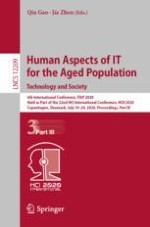This three volume set of LNCS 12207, 12208 and 12209 constitutes the refereed proceedings of the 6th International Conference on Human Aspects of IT for the Aged Population, ITAP 2020, held as part of the 22nd International Conference, HCI International 2020, which took place in Copenhagen, Denmark, in July 2020. The conference was held virtually due to the COVID-19 pandemic.
The total of 1439 papers and 238 posters have been accepted for publication in the HCII 2020 proceedings from a total of 6326 submissions.
ITAP 2020 includes a total of 104 regular papers which are organized in topical sections named: Involving Older Adults in HCI Methodology , User Experience and Aging, Aging and Mobile and Wearable Devices, Health and Rehabilitation Technologies, Well-being, Persuasion, Health Education and Cognitive Support, Aging in Place, Cultural and Entertainment Experiences for Older Adults, Aging and Social Media, Technology Acceptance and Societal Impact.
